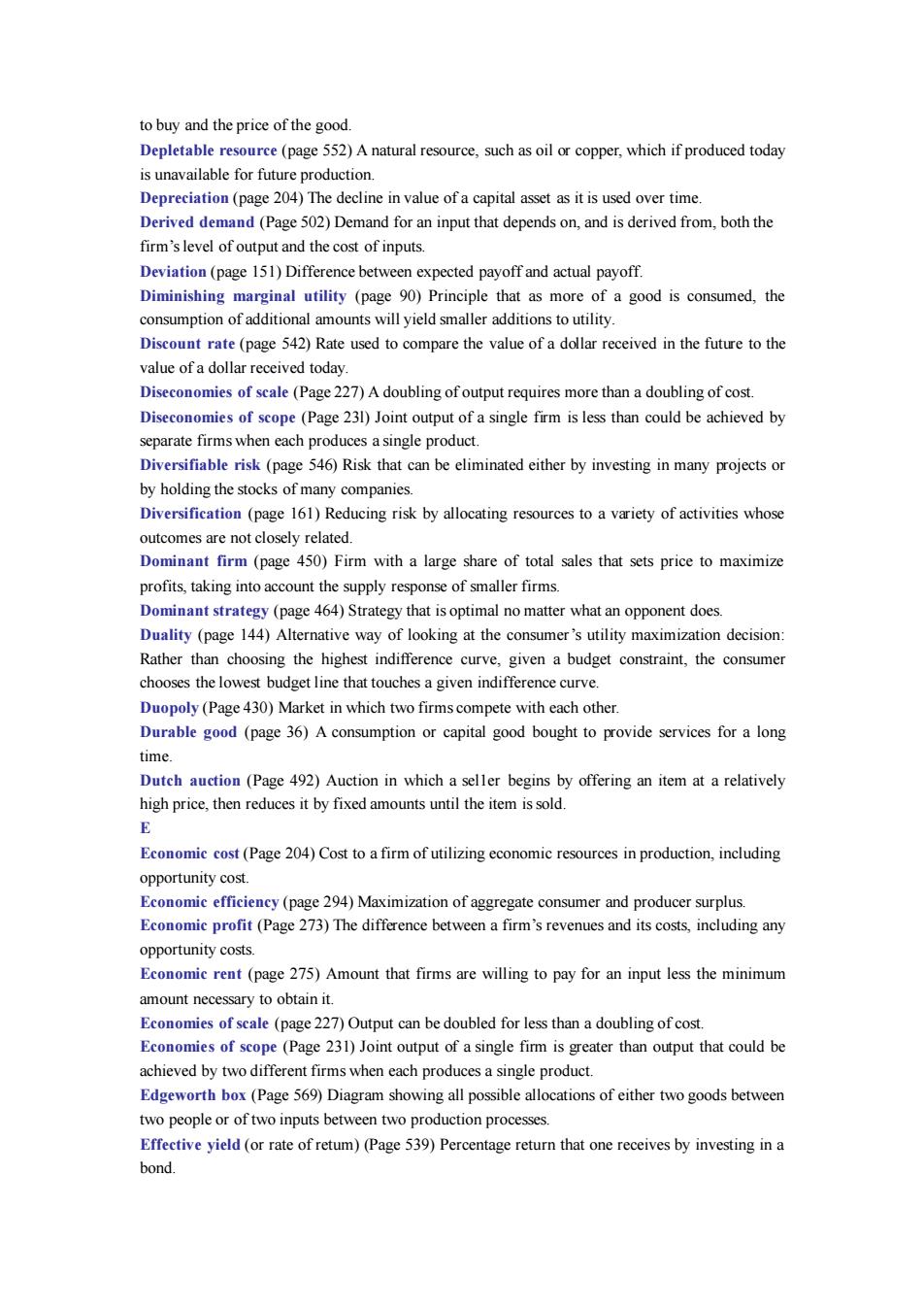正在加载图片...

to buy and the price of the good. Depletablee(page 552).such which if produced today Depreciation (page 204)The decline in value of a capital asset as it is used over time Derived demand (Page 502)Demand for an input that depends on.and is derived from.both the firm's level of output and the cost of inputs. Deviation(page 151)Difference betwee expected payoff and actual payoff. Diminishingmar utility (page 9) Principle that t as more of a good is consumed,the consumption of additional amounts will yield smaller additions to utility. Discount rate (page 542)Rate used to compare the value of a dollar received in the future to the value of a dollar received today. Diseconomies of scale (Page 227)A doubling of output requires more than a doubling of cost scope(Page23)of a single frm is ss than cou be achieved by separate firms when each produ ces a single product Diversifiable risk (page 546)Risk that can be eliminated either by investing in many projects or by holding the stocks of many companies. Diversification(page 161)Reducing risk by allocating resources to a variety of activities whose outcomes are not c sely related (page 450)Firm with a large share of total sales that sets price to maximize profits,taking into account the supply response of smaller firms Dominant strategy (page 464)Strategy that is optimal no matter what an opponent does. Duality (page 144)Alternative way of looking at the consumer's utility maximization decision Rather than choosing the highest indiffere curve.givena budget consraint,the chooses the lowe bud hes a given indiffer Duopoly (Page 430)Market in which two firmscompete with each other Durable good (page 36)A consumption or capital good bought to provide services for a long time Dutch auction (Page 492)auction in which a seller begins by offering an item at a relatively high price,then red uces it by fixed amounts until the item issold Economic cost (Page 204)Cost to a firm of utilizing economic resources in production,including opportunity cost. Economie efficiency (page 294)Maximization of agg regate consumer and nroducer surnlus Economic profit(Page 273)The difference between a firm's revenues and its costs,including any opportunityc Economic rent(page 275)Amount that firms are willing to pay for an input less the minimum amount necessary to obtain it Economies of scale (page 227)Output can be doubled for less than a doubling of cost Economies of scope (Page 231)Joint output of a single fimm is greater than output that could be achieved by two differ firm s when ch producesa nge product. (Page569)Diagram showing all possible alocations of either two goods between two people or of two inputs between two production processes. Effective yield(or rate of retum)(Page 539)Percentage return that one receives by investing in a hond to buy and the price of the good. Depletable resource (page 552) A natural resource, such as oil or copper, which if produced today is unavailable for future production. Depreciation (page 204) The decline in value of a capital asset as it is used over time. Derived demand (Page 502) Demand for an input that depends on, and is derived from, both the firm’s level of output and the cost of inputs. Deviation (page 151) Difference between expected payoff and actual payoff. Diminishing marginal utility (page 90) Principle that as more of a good is consumed, the consumption of additional amounts will yield smaller additions to utility. Discount rate (page 542) Rate used to compare the value of a dollar received in the future to the value of a dollar received today. Diseconomies of scale (Page 227) A doubling of output requires more than a doubling of cost. Diseconomies of scope (Page 23l) Joint output of a single firm is less than could be achieved by separate firms when each produces a single product. Diversifiable risk (page 546) Risk that can be eliminated either by investing in many projects or by holding the stocks of many companies. Diversification (page 161) Reducing risk by allocating resources to a variety of activities whose outcomes are not closely related. Dominant firm (page 450) Firm with a large share of total sales that sets price to maximize profits, taking into account the supply response of smaller firms. Dominant strategy (page 464) Strategy that is optimal no matter what an opponent does. Duality (page 144) Alternative way of looking at the consumer’s utility maximization decision: Rather than choosing the highest indifference curve, given a budget constraint, the consumer chooses the lowest budget line that touches a given indifference curve. Duopoly (Page 430) Market in which two firms compete with each other. Durable good (page 36) A consumption or capital good bought to provide services for a long time. Dutch auction (Page 492) Auction in which a sel1er begins by offering an item at a relatively high price, then reduces it by fixed amounts until the item is sold. E Economic cost (Page 204) Cost to a firm of utilizing economic resources in production, including opportunity cost. Economic efficiency (page 294) Maximization of aggregate consumer and producer surplus. Economic profit (Page 273) The difference between a firm’s revenues and its costs, including any opportunity costs. Economic rent (page 275) Amount that firms are willing to pay for an input less the minimum amount necessary to obtain it. Economies of scale (page 227) Output can be doubled for less than a doubling of cost. Economies of scope (Page 231) Joint output of a single firm is greater than output that could be achieved by two different firms when each produces a single product. Edgeworth box (Page 569) Diagram showing all possible allocations of either two goods between two people or of two inputs between two production processes. Effective yield (or rate of retum) (Page 539) Percentage return that one receives by investing in a bond